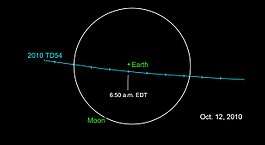2010 TD54
2010 TD54 is a tiny asteroid and fast rotator, classified as near-Earth object of the Apollo group, approximately 5 meters in diameter. It was first observed by the Mount Lemmon Survey in October 2010, when the asteroid crossed through the Earth-moon system and had a close encounter with Earth.[4]
 Orbital diagram of 2010 TD54 during its near-Earth encounter on 12 Oct 2010 | |
| Discovery [1] | |
|---|---|
| Discovered by | Mount Lemmon Srvy. |
| Discovery site | Mount Lemmon Obs. |
| Discovery date | 9 October 2010 |
| Designations | |
| 2010 TD54 | |
| NEO · Apollo [1][2] | |
| Orbital characteristics [1] | |
| Epoch 4 September 2017 (JD 2458000.5) | |
| Uncertainty parameter 6 | |
| Observation arc | 3 days |
| Aphelion | 3.2396 AU |
| Perihelion | 0.7020 AU |
| 1.9708 AU | |
| Eccentricity | 0.6438 |
| 2.77 yr (1,011 days) | |
| 159.97° | |
| 0° 21m 22.32s / day | |
| Inclination | 4.3045° |
| 18.607° | |
| 76.068° | |
| Earth MOID | 0.000178 AU 0.0693 LD |
| Physical characteristics | |
| Dimensions | 5 m[3] 5–10 m[4] |
| 0.01167 h (dated)[5] 0.0229317 h[3][lower-alpha 1] | |
| 0.20 (assumed)[3] | |
| Srv [6] | |
| 28.9[1] | |
Orbit and classification
2010 TD54 orbits the Sun at a distance of 0.7–3.2 AU once every 2 years and 9 months (1,011 days). Its orbit has an eccentricity of 0.64 and an inclination of 4° with respect to the ecliptic.[1]
The body's observation arc begins with its first observations by the Mount Lemmon Survey and only spans over a period of 3 days until 12 October 2010. It has been observed since then.[2]
Close approach
2010 TD54 made its closest approach at 10:51, 12 October 2010 UTC (6:51 EDT a.m.) at 0.000346 AU (51,800 km; 32,200 mi). It is one of the closest known approaches of an asteroid to Earth, at which time the object appeared at a magnitude of 14. It was first observed by of the Catalina Sky Survey's telescopes north of Tucson, Arizona on 9 October 2010.[4]
It has an Earth minimum orbit intersection distance of 0.000178086 AU (26,600 km; 16,600 mi), which corresponds to 0.0693 lunar distance.[1] It was removed from the Sentry Risk Table on 11 October 2010.[7] The asteroid may have passed 0.0009 AU (135,000 km; 83,700 mi) from Earth in October 1979, but the nominal orbit suggests it passed millions of kilometres from Earth in 1979.[1]
Physical characteristics
2010 TD54 is a stony asteroid, characterized as a Srv subtype.[6]
Rotation period
In November 2010, a rotational lightcurve of 2010 TD54 was obtained from photometric observations, which showed that the asteroid is a fast rotator. Lightcurve analysis gave a well-defined rotation period of 0.0229317 hours (1 minute and 23 seconds) with a brightness amplitude of 0.92 magnitude (U=3). A high amplitude typically indicates that the body has an irregular, elongated rather than spherical shape.[lower-alpha 1] This result supersedes a previously obtained lightcurve with a shorter period of 0.01167 hours (U=1).[5]
Diameter and albedo
The Collaborative Asteroid Lightcurve Link assumes a standard albedo for stony asteroids of 0.20 and calculates a diameter of 5 metres (16 feet) based on an absolute magnitude of 28.9.[3] NASA's press release gave an estimated diameter of 5 to 10 meters (16 to 33 feet).[4]
See also
- List of asteroid close approaches to Earth, for other close approaches
- List of asteroid close approaches to Earth in 2010
Notes
References
- "JPL Small-Body Database Browser: (2010 TD54)" (2010-10-12 last obs.). Jet Propulsion Laboratory. Retrieved 28 September 2017.
- "2010 TD54". Minor Planet Center. Retrieved 28 September 2017.
- "LCDB Data for 2012 TC4". Asteroid Lightcurve Database (LCDB). Retrieved 28 September 2017.
- "Small Asteroid to Pass Within Earth-Moon System Tuesday". NASA. 11 October 2010. Retrieved 28 September 2017.
- Hicks, M.; Rhoades, H. (October 2010). "The near-Earth asteroid 2010 TD54: The fastest rotating natural body known in the solar system?". The Astronomer's Telegram (2984). Bibcode:2010ATel.2984....1H. Retrieved 28 September 2017.
- Popescu, M.; Birlan, M.; Binzel, R.; Vernazza, P.; Barucci, A.; Nedelcu, D. A.; et al. (November 2011). "Spectral properties of eight near-Earth asteroids". Astronomy and Astrophysics. 535: 15. Bibcode:2011A&A...535A..15P. doi:10.1051/0004-6361/201117118. Retrieved 28 September 2017.
- "Sentry: Earth Impact Monitoring – Removed Objects". NASA/JPL CINEOS – Center for Near Earth Object Studies. Retrieved 28 September 2017.
External links
- Asteroid 2010 TD54's Orbit Around the Sun
- Small Asteroid to Pass Within Earth-Moon System Tuesday 10.11.10
- The near-Earth asteroid 2010 TD54: The fastest rotating natural body known in the solar system? 29 Oct 2010
- Asteroid Lightcurve Database (LCDB), query form (info)
- 2010 TD54 at NeoDyS-2, Near Earth Objects—Dynamic Site
- Ephemeris · Obs prediction · Orbital info · MOID · Proper elements · Obs info · Close · Physical info · NEOCC
- 2010 TD54 at the JPL Small-Body Database
